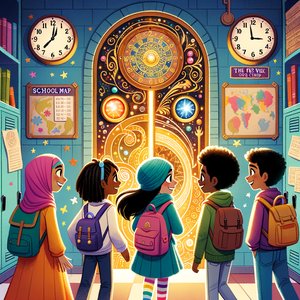The Door Between Periods

On the second day of sixth grade, Alder Creek Middle smelled like floor wax and pencil shavings and the warm, buttery pretzels they sold in the cafeteria on Tuesdays. The banners the PTA had taped to the main hallway still drooped at the corners: WELCOME BACK! and YOU BELONG HERE, the exclamation points a little wrinkled from the humidity.
Maya Chen balanced her stack of new notebooks against her hip and weaved through a knot of seventh graders discussing the soccer tryouts. She liked this time of morning, the stampede before the first bell, when everyone was somewhere between who they were last year and whoever they might turn into by winter. Her best friend, Jasper Reed, popped out from behind the trophy case like a meerkat, his backpack hanging open and a pencil tucked behind his ear. He was always mid-sketch or mid-joke—usually both.
“Chen!” he said, pointing his pencil at her like a wand. “Emergency. I used graph paper for math and now I can’t see straight lines anymore.”
“That’s what graph paper is for,” Maya said. “Where’s Amira?”
“Here,” said a calm voice. Amira Patel slid in beside them, her hair in a neat braid and a schedule color-coded with highlighters. She had already memorized the layout of the building and could quote the lunch menu for the next two weeks. “Homeroom is Ms. Flores, Room 203, and we should probably walk now if we don’t want the late bell on day two.”
They set off together, past the mural of a salmon jumping over painted rocks—Alder Creek’s mascot—and a bulletin board crammed with club flyers. Something about Robotics. Something about Yearbook. Something about Gardening Club needing volunteers to water the herbs on the roof.
Maya liked learning new paths, making a map in her head as she walked: three turns from the gym to the library, two exits to the courtyard, a shortcut that avoided the clogged Hallway of Locker Slams. Her mom said she had a good sense of direction. Her little brother said she was basically a human pigeon.
Homeroom passed in a blur of forms and reminders and the announcements crackling through the speakers: Please remember to write your name on your lunch boxes. Please do not bring live insects to school again. Maya circled Art on her schedule with a small star. Fourth period. Mr. Holloway. “He’s the one who makes wire sculptures out of old hangers,” Jasper whispered. “He turned a coat rack into a dragon last spring.”
By the time the first three periods had marched past—science safety contracts, social studies expectations, a quiz in math that was not supposed to count but still made her palms sweaty—Maya needed the soft hum of the art room like a plant needed sun. Mr. Holloway wore a shirt with paint smudges that looked intentional and a tie patterned with tiny pencils. Sunlight slipped through the tall windows in streaks; the tables were speckled; the room smelled faintly of clay.
“Welcome, makers!” he said, clapping once. “Today, we begin with maps. Not Google, not atlases—your maps. Draw the path you take every morning to get here. Not just streets. Moments. Do you pass a cat? A blue mailbox? A puddle that never goes away? Put those down. The map is the story of your steps.”
He sent them to the supply cabinet for large sheets of paper, and that was when Maya found it. She slid a drawer and saw a thin cardboard tube tucked behind the watercolor pads, the end capped with a circle of masking tape. Someone had written in looping handwriting: DO NOT THROW AWAY.
“Is this for anyone?” she asked.
Mr. Holloway glanced over. “Oh! That’s from last year, I think. Stage crew left some scenery plans here. You can look, but be gentle, please. Some of those lines are made with fancy ink that smudges if it sneezes.”
Maya eased the tape off and slid out a rolled sheet. It unfurled with a soft sigh across the table. Jasper leaned in. Amira adjusted her glasses. The paper was thick and creamy, faintly yellowed. In the middle was a detailed drawing of Alder Creek Middle: halls, rooms, staircases, labels in neat print. But it wasn’t exactly the map on the school website. The art room—Room 117—had a tiny half-number written beside it in darker ink, like a whisper: 117½. The west stairwell had a note, small and careful: SQUEAKS ON 4TH STEP. The library had a tiny feather drawn in the corner, and someone had shaded the little rectangle of the rooftop door with a hatch pattern that looked like rain.
At the bottom, in thin green letters that might have been done with a fountain pen, someone had written: ALDER CREEK MIDDLE—INTERNAL CIRCULATION PLAN. REVISION: BELL 0.
“What’s Bell 0?” Jasper said, as if the paper would answer.
“There is no Bell 0,” Amira said, but her voice did a tiny wobble. “We have seven periods. The bell rings between them.”
Maya reached for a pencil. She wanted to trace the shape of their route as Mr. Holloway had asked. As she lowered the pencil tip, she noticed something else. Next to the auditorium wall was a small rectangle labeled MAINTENANCE C. A break room? A closet? In the corner there was a line so fine she almost missed it, leading from MAINTENANCE C to a square that wasn’t on any map she’d seen. The square had no label, only a dashed outline and a note in those green letters: WHEN CLOCKS DISAGREE.
“Do you think stage crew made this?” Maya whispered.
“Or the custodians,” Jasper said. “Maybe it’s their secret snack stash.”
“You two and your theories,” Amira said, but she was leaning in, too. “It’s probably a joke.”
Mr. Holloway wandered past and smiled at the tangle of their heads. “Find something interesting?”
“It’s the school,” Maya said. “But not. There’s a half-number. And ‘Bell 0.’ And…” She hesitated. She didn’t know why she didn’t want to say the part about the clocks out loud.
“Stage crew loves to draw things the rest of us can’t see,” Mr. Holloway said, looking fondly at the blueprint. “You can use the big paper if you want. Keep the roll on our table.”
They drew through the rest of the period, but Maya’s eyes kept flicking to the fine green letters. When the bell rang for lunch, the room burst into scraping chairs and chatter. Jasper rolled the map back up and tucked it under his arm like a pirate with a treasure scroll.
“In the cafeteria?” he said, waggling his eyebrows. “We can spread it out and see if it matches the layout.”
Amira hesitated. “We can look. But if a teacher says put it away, we put it away.”
The cafeteria sounded like a storm of trays. They squeezed into a table near the back, dodging a group of eighth graders guarding a mountain of fries. Maya laid the map out flat again, pinning the corners with milk cartons. She traced the way from the art room to the lunch line with her finger, then lifted her head to check the path in real life. The hallway she could see through the open doorway matched… except for one thing. The small storage door by the auditorium—just a gray door with a faded sign that said CUSTODIAL—now had a scrap of paper taped to it with a number scrawled in black marker.
117½.
“Did you see that before?” Jasper asked.
“No.” Amira’s voice was quiet. “That wasn’t there earlier.”
Maya stared until the numbers blurred. She checked the big clock over the lunch line. It said 12:02 a.m. Her watch—she had set it off the first bell that morning—said 12:04.
“Clocks disagreeing,” she said before she could stop herself.
Jasper followed her gaze and whistled softly. “Okay, that’s weird.”
“Coincidence,” Amira said, but she was already folding her schedule and tucking it into her pocket like she might need both hands free.
They ate quickly. Jasper traded his carrot sticks for two of Maya’s apple slices. A napkin sailed by. The eighth graders started chanting something about extra ketchup. When the noise swelled, Maya looked down at the map and forgot to breathe.
The line—the fine, almost invisible line that led from MAINTENANCE C across the page—was darker. Not new, exactly. But it had thickened in places, the way a trail looks after a lot of feet have passed. Next to the dashed square with the no-name box, there was a tiny line of text that hadn’t been there: TODAY.
“Okay,” Jasper said softly. “That’s not possible.”
“Maybe someone’s messing with us,” Amira said, but she sounded like she wanted the sentence to convince her.
The lunch bell rang for clean-up. Trays clattered. Maya reached out and traced the letters with the barest tip of her finger. The ink wasn’t wet; the paper was warm under her skin, though, as if someone had just pulled it from a sunny window.
“We have twenty minutes,” she said. “We could just… walk past.”
“Walk past,” Amira echoed. “Not open anything. Not get detention.”
Maya rolled up the map and hugged it against her chest. The three of them slipped through the churning cafeteria and into the main hall, keeping to the edges like fish. The posters watched them with printed eyes: JOIN BAND, SPANISH CLUB MEETS TUESDAY, LOST: ONE BLUE WATER BOTTLE WITH STICKERS. If anyone noticed them, it was only as three sixth graders orbiting around older planets.
At the corner by the auditorium, the custodial door waited. Up close, the scrap of paper with 117½ had been taped on with careful rectangles at all four corners, like whoever had done it didn’t want it to fall. The gray paint on the door was chipped where hands had pressed for years. A thin line of light showed at the bottom, as if the floor on the other side dropped away quickly. The big clock above the lobby said 12:12. Maya’s watch said 12:09.
“Three minutes off,” Jasper murmured. “Or three minutes on. Depends which clock is wrong.”
“Or which one is right,” Amira said.
A group of chorus kids tumbled past, laughing. A custodian with a bucket nodded to them and kept going. The hall quieted like someone had turned the volume knob to the left. Maya could hear the hum of the lights and the whisper of air vents. She could hear her own breath.
“We’re just looking,” she said. “We look, and if it’s locked, we go back to class.”
Jasper put his palm on the metal handle. “It’s cold.” He glanced at Maya. “On three?”
“Wait,” Amira said. “What if there’s—”
The PA system crackled to life. They all jumped. “Good afternoon,” came the vice principal’s voice, cheerful and a little tinny. “Just a reminder that the Book Fair opens in the library after school. Also, please do not prop open exterior doors.” The speaker went quiet with a soft click. Maya snorted out a breath she didn’t realize she’d been holding and felt a laugh start in her chest, then turn into something else when she saw Jasper’s eyes.
“On three,” he whispered. “One… two…”
The handle moved before they touched it. It turned a fraction, like a held breath let go. From the crack along the floor, a thread of cool air unspooled across their sneakers, smelling faintly of rain on old paper. The scrap of paper with 117½ rustled in a draft none of the hallway vents made.
Maya’s fingers tightened on the rolled map. The green ink at the edge pulsed once under her palm, not a light, not a glow—just the feeling of something alive shifting from sleep.
“Three,” Jasper breathed, as the door eased inward from the other side.
Autor zakończenia:

 English
English
 polski
polski
 Co było dalej?
Co było dalej?



